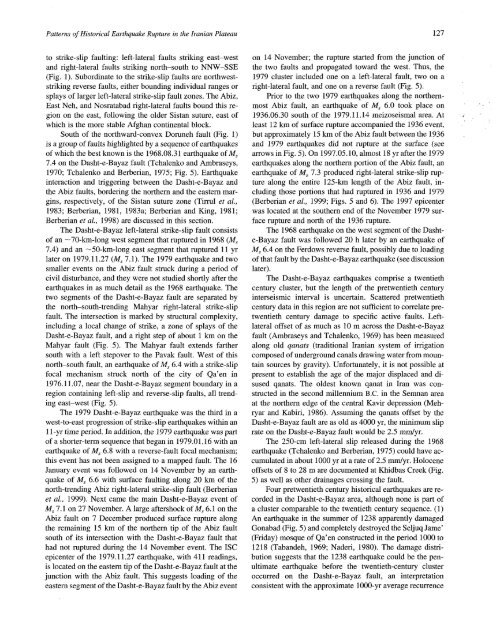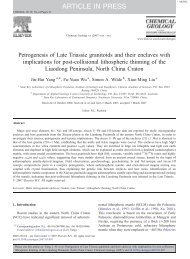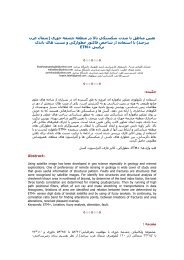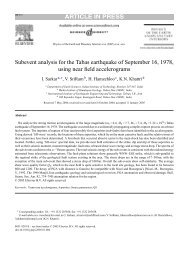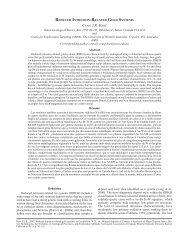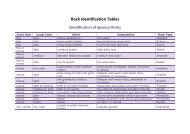Patterns of Historical Earthquake Rupture in the Iranian Plateau
Patterns of Historical Earthquake Rupture in the Iranian Plateau
Patterns of Historical Earthquake Rupture in the Iranian Plateau
- No tags were found...
You also want an ePaper? Increase the reach of your titles
YUMPU automatically turns print PDFs into web optimized ePapers that Google loves.
<strong>Patterns</strong> <strong>of</strong> <strong>Historical</strong> <strong>Earthquake</strong> <strong>Rupture</strong> <strong>in</strong> <strong>the</strong> <strong>Iranian</strong> <strong>Plateau</strong> 127to strike-slip fault<strong>in</strong>g: left-lateral faults strik<strong>in</strong>g east-westand right-lateral faults strik<strong>in</strong>g north-south to NNW-SSE(Fig. 1). Subord<strong>in</strong>ate to <strong>the</strong> strike-slip faults are northweststrik<strong>in</strong>greverse faults, ei<strong>the</strong>r bound<strong>in</strong>g <strong>in</strong>dividual ranges orsplays <strong>of</strong> larger left-lateral strike-slip fault zones. The Abiz,East Neh, and Nosratabad right-lateral faults bound this regionon <strong>the</strong> east, follow<strong>in</strong>g <strong>the</strong> older Sistan suture, east <strong>of</strong>which is <strong>the</strong> more stable Afghan cont<strong>in</strong>ental block.South <strong>of</strong> <strong>the</strong> northward-convex Doruneh fault (Fig. 1)is a group <strong>of</strong> faults highlighted by a sequence <strong>of</strong> earthquakes<strong>of</strong> which <strong>the</strong> best known is <strong>the</strong> 1968.08.31 earthquake <strong>of</strong> Ms7.4 on <strong>the</strong> Dasht-e-Bayaz fault (Tchalenko and Ambraseys,1970; Tchalenko and Berberian, 1975; Fig. 5). <strong>Earthquake</strong><strong>in</strong>teraction and trigger<strong>in</strong>g between <strong>the</strong> Dasht-e-Bayaz and<strong>the</strong> Abiz faults, border<strong>in</strong>g <strong>the</strong> nor<strong>the</strong>rn and <strong>the</strong> eastern marg<strong>in</strong>s,respectively, <strong>of</strong> <strong>the</strong> Sistan suture zone (Tirrul et al.,1983; Berberian, 1981, 1983a; Berberian and K<strong>in</strong>g, 1981;Berberian et al., 1998) are discussed <strong>in</strong> this section.The Dasht-e-Bayaz left-lateral strike-slip fault consists<strong>of</strong> an -70-km-long west segment that ruptured <strong>in</strong> 1968 (Ms7.4) and an --50-km-long east segment that ruptured 11 yrlater on 1979.11.27 (Ms 7.1). The 1979 earthquake and twosmaller events on <strong>the</strong> Abiz fault struck dur<strong>in</strong>g a period <strong>of</strong>civil disturbance, and <strong>the</strong>y were not studied shortly after <strong>the</strong>earthquakes <strong>in</strong> as much detail as <strong>the</strong> 1968 earthquake. Thetwo segments <strong>of</strong> <strong>the</strong> Dasht-e-Bayaz fault are separated by<strong>the</strong> north-south-trend<strong>in</strong>g Mahyar right-lateral strike-slipfault. The <strong>in</strong>tersection is marked by structural complexity,<strong>in</strong>clud<strong>in</strong>g a local change <strong>of</strong> strike, a zone <strong>of</strong> splays <strong>of</strong> <strong>the</strong>Dasht-e-Bayaz fault, and a right step <strong>of</strong> about 1 km on <strong>the</strong>Mahyar fault (Fig. 5). The Mahyar fault extends far<strong>the</strong>rsouth with a left stepover to <strong>the</strong> Pavak fault. West <strong>of</strong> thisnorth-south fault, an earthquake <strong>of</strong> Ms 6.4 with a strike-slipfocal mechanism struck north <strong>of</strong> <strong>the</strong> city <strong>of</strong> Qa’en <strong>in</strong>1976.11.07, near <strong>the</strong> Dasht-e-Bayaz segment boundary <strong>in</strong> aregion conta<strong>in</strong><strong>in</strong>g left-slip and reverse-slip faults, all trend<strong>in</strong>geast-west (Fig. 5).The 1979 Dasht-e-Bayaz earthquake was <strong>the</strong> third <strong>in</strong> awest-to-east progression <strong>of</strong> strike-slip earthquakes with<strong>in</strong> an11-yr time period. In addition, <strong>the</strong> 1979 earthquake was part<strong>of</strong> a shorter-term sequence that began <strong>in</strong> 1979.01.16 with anearthquake <strong>of</strong> M s 6.8 with a reverse-fault focal mechanism;this event has not been assigned to a mapped fault. The 16January event was followed on 14 November by an earthquake<strong>of</strong> Ms 6.6 with surface fault<strong>in</strong>g along 20 km <strong>of</strong> <strong>the</strong>north-trend<strong>in</strong>g Abiz fight-lateral strike-slip fault (Berberianet al., 1999). Next came <strong>the</strong> ma<strong>in</strong> Dasht-e-Bayaz event <strong>of</strong>Ms 7.1 on 27 November. A large aftershock <strong>of</strong> Ms 6.1 on <strong>the</strong>Abiz fault on 7 December produced surface rupture along<strong>the</strong> rema<strong>in</strong><strong>in</strong>g 15 km <strong>of</strong> <strong>the</strong> nor<strong>the</strong>rn tip <strong>of</strong> <strong>the</strong> Abiz faultsouth <strong>of</strong> its <strong>in</strong>tersection with <strong>the</strong> Dasht-e-Bayaz fault thathad not ruptured dur<strong>in</strong>g <strong>the</strong> 14 November event. The ISCepicenter <strong>of</strong> <strong>the</strong> 1979.11.27 earthquake, with 411 read<strong>in</strong>gs,is located on <strong>the</strong> eastern tip <strong>of</strong> <strong>the</strong> Dasht-e-Bayaz fault at <strong>the</strong>junction with <strong>the</strong> Abiz fault. This suggests load<strong>in</strong>g <strong>of</strong> <strong>the</strong>eastern segment <strong>of</strong> <strong>the</strong> Dasht-e-Bayaz fault by <strong>the</strong> Abiz eventon 14 November; <strong>the</strong> rupture started from <strong>the</strong> junction <strong>of</strong><strong>the</strong> two faults and propagated toward <strong>the</strong> west. Thus, <strong>the</strong>1979 cluster <strong>in</strong>cluded one on a left-lateral fault, two on aright-lateral fault, and one on a reverse fault (Fig. 5).Prior to <strong>the</strong> two, 1979 earthquakes along <strong>the</strong> nor<strong>the</strong>rnmostAbiz fault, an earthquake <strong>of</strong> M s 6.0 took place on1936.06.30 south <strong>of</strong><strong>the</strong> 1979.11.14 meizoseismal area. Atleast 12 km <strong>of</strong> surface rupture accompanied <strong>the</strong> 1936 event,but approximately 15 km <strong>of</strong> <strong>the</strong> Abiz fault between <strong>the</strong> 1936and 1979 earthquakes did not rupture at <strong>the</strong> surface (seearrows <strong>in</strong> Fig. 5). On 1997.05.10, almost 18 yr after <strong>the</strong> 1979earthquakes along <strong>the</strong> nor<strong>the</strong>rn portion <strong>of</strong> <strong>the</strong> Abiz fault, anearthquake <strong>of</strong> Ms 7.3 produced right-lateral strike-slip rupturealong <strong>the</strong> entire 125-km length <strong>of</strong> <strong>the</strong> Abiz fault, <strong>in</strong>clud<strong>in</strong>gthose portions that had ruptured <strong>in</strong> 1936 and 1979(Berberian et al., 1999; Figs. 5 and 6). The 1997 epicenterwas located at <strong>the</strong> sou<strong>the</strong>rn end <strong>of</strong> <strong>the</strong> November 1979 surfacerupture and north <strong>of</strong> <strong>the</strong> 1936 rupture.The 1968 earthquake on <strong>the</strong> west segment <strong>of</strong> <strong>the</strong> Dashte-Bayazfault was followed 20 h later by an earthquake <strong>of</strong>Ms 6.4 on <strong>the</strong> Ferdo.ws reverse fault, possibly due to load<strong>in</strong>g<strong>of</strong> that fault by <strong>the</strong> Dasht-e-Bayaz earthquake (see discussionlater).The Dasht-e-Bayaz earthquakes comprise a twentiethcentury cluster, but <strong>the</strong> length <strong>of</strong> <strong>the</strong> pretwentieth century<strong>in</strong>terseismic <strong>in</strong>terval is uncerta<strong>in</strong>. Scattered pretwentiethcentury data <strong>in</strong> this region are not sufficient to correlate pretwentiethcentury damage to specific active faults. Leftlateral<strong>of</strong>fset <strong>of</strong> as much as 10 m across <strong>the</strong> Dasht-e-Bayazfault (Ambraseys and Tchalenko, 1969) has been measuredalong old qanats (traditional <strong>Iranian</strong> system <strong>of</strong> irrigationcomposed <strong>of</strong> underground canals draw<strong>in</strong>g water from mounta<strong>in</strong>sources by gravity). Unfortunately, it is not possible atpresent to establish <strong>the</strong> age <strong>of</strong> <strong>the</strong> major displaced and disusedqanats. The oldest known qanat <strong>in</strong> Iran was constructed<strong>in</strong> <strong>the</strong> second millennium B.C. <strong>in</strong> <strong>the</strong> Semnan areaat <strong>the</strong> nor<strong>the</strong>rn edge <strong>of</strong> <strong>the</strong> central Kavir depression (Mehryarand Kabiri, 1986). Assum<strong>in</strong>g <strong>the</strong> qanats <strong>of</strong>fset by <strong>the</strong>Dasht-e-Bayaz fault are as old as 4000 yr, <strong>the</strong> m<strong>in</strong>imum sliprate on <strong>the</strong> Dasht-e-Bayaz fault would be 2.5 mm/yr.The 250-cm left-lateral slip released dur<strong>in</strong>g <strong>the</strong> 1968earthquake (Tchalenko and Berberian, 1975) could have accumulated<strong>in</strong> about 1000 yr at a rate <strong>of</strong> 2.5 mm/yr. Holocene<strong>of</strong>fsets <strong>of</strong> 8 to 28 m are documented at Khidbas Creek (Fig.5) as well as o<strong>the</strong>r dra<strong>in</strong>ages cross<strong>in</strong>g <strong>the</strong> fault.Four pretwentieth century historical earthquakes are recorded<strong>in</strong> <strong>the</strong> Dasht-e-Bayaz area, although none is part <strong>of</strong>a cluster comparable to <strong>the</strong> twentieth century sequence. (1)An earthquake <strong>in</strong> <strong>the</strong> summer <strong>of</strong> 1238 apparently damagedGonabad (Fig. 5) and completely destroyed <strong>the</strong> Seljuq Jame’(Friday) mosque <strong>of</strong> Qa’en constructed <strong>in</strong> <strong>the</strong> period 10001218 (Tabandeh, 1969; Naderi, 1980). The damage distributionsuggests that <strong>the</strong> 1238 earthquake could be <strong>the</strong> penultimateearthquake before <strong>the</strong> twentieth-century clusteroccurred on <strong>the</strong> Dasht-e-Bayaz fault, an <strong>in</strong>terpretationconsistent with <strong>the</strong> approximate 1000-yr average recurrence


